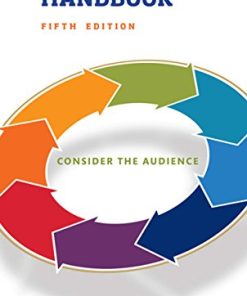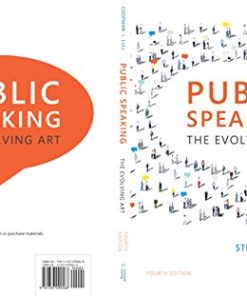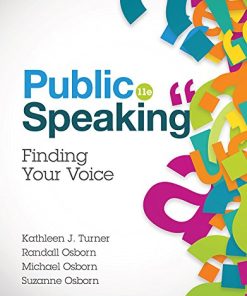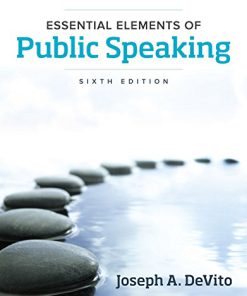The Art Of Public Speaking 13th Edition by Stephen Lucas 1259924602 978-1259924606
$50.00 Original price was: $50.00.$25.00Current price is: $25.00.
The Art Of Public Speaking 13th Edition by Stephen E. Lucas – Ebook PDF Instant Download/DeliveryISBN: 1259924602 978-1259924606
Full download The Art Of Public Speaking 13th Edition after payment.
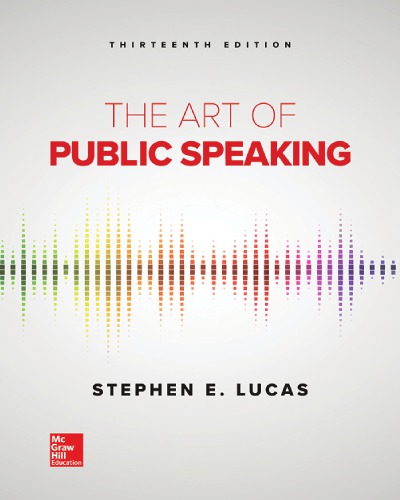
Product details:
ISBN-10 : 1259924602
ISBN-13 : 978-1259924606
Author : Stephen E. Lucas
Fully updated for the thirteenth edition, the award-winning The Art of Public Speaking offers a time-tested approach that has made it the most widely used college textbook on its subject in the world. Seamlessly coordinated with Connect, McGraw-Hill Education’s pathbreaking online program, it supplies a proven set of teaching and learning tools that is without parallel among public speaking books.
For experienced instructors, The Art of Public Speaking presents a solid, fully customizable foundation and an abundance of teaching aids from which to choose, allowing for complete teaching flexibility in the course. For novice instructors, its wisdom, steady hand, and unmatched ancillary package instill confidence and build success in the classroom from day one.
The Art Of Public Speaking 13th Table of contents:
Chapter 1: Speaking in Public
Chapter 1 Introduction
The Power of Public Speaking
The Tradition of Public Speaking
Public Speaking and Conversation
Similarities Between Public Speaking and Conversation
Differences Between Public Speaking and Conversation
Developing Confidence: Your Speech Class
Nervousness Is Normal
Dealing with Nervousness
Public Speaking and Critical Thinking
The Speech Communication Process
Speaker
Message
Channel
Listener
Feedback
Interference
Situation
The Speech Communication Process: Example with Commentary
Public Speaking in a Culturally Diverse World
Cultural Diversity and Public Speaking
Avoiding Ethnocentrism
Summary
Key Terms
Review Questions
Exercises for Critical Thinking
End Notes
Chapter 2: Ethics and Public Speaking
Chapter 2 Introduction
The Importance of Ethics
Guidelines for Ethical Speaking
Make Sure Your Goals Are Ethically Sound
Be Fully Prepared for Each Speech
Be Honest in What You Say
Avoid Name-Calling and Other Forms of Abusive Language
Put Ethical Principles into Practice
Plagiarism
Global Plagiarism
Patchwork Plagiarism
Incremental Plagiarism
Plagiarism and the Internet
Guidelines for Ethical Listening
Be Courteous and Attentive
Avoid Prejudging the Speaker
Maintain the Free and Open Expression of Ideas
Summary
Key Terms
Review Questions
Exercises for Critical Thinking
End Notes
Chapter 3: Listening
Chapter 3 Introduction
Listening Is Important
Listening and Critical Thinking
Four Causes of Poor Listening
Not Concentrating
Listening Too Hard
Jumping to Conclusions
Focusing on Delivery and Personal Appearance
How to Become a Better Listener
Take Listening Seriously
Be an Active Listener
Resist Distractions
Don’t Be Diverted by Appearance or Delivery
Suspend Judgment
Focus Your Listening
Develop Note-Taking Skills
Summary
Key Terms
Review Questions
Exercises for Critical Thinking
End Notes
Chapter 4: Giving Your First Speech
Chapter 4 Introduction
Preparing Your Speech
Developing the Speech
Organizing the Speech
Delivering Your Speech
Speaking Extemporaneously
Rehearsing the Speech
Presenting the Speech
Sample Speeches with Commentary
The Inevitability of Evette
The Color Purple
Twists and Turns
Summary
Key Terms
Review Questions
Exercises for Critical Thinking
Chapter 5: Selecting a Topic and a Purpose
Chapter 5 Introduction
Choosing a Topic
Topics You Know a Lot About
Topics You Want to Know More About
Brainstorming for Topics
Determining the General Purpose
Determining the Specific Purpose
Tips for Formulating the Specific Purpose Statement
Questions to Ask About Your Specific Purpose
Phrasing the Central Idea
What Is the Central Idea?
Guidelines for the Central Idea
Summary
Key Terms
Review Questions
Exercises for Critical Thinking
Chapter 6: Analyzing the Audience
Chapter 6 Introduction
Audience-Centeredness
Your Classmates as an Audience
The Psychology of Audiences
Demographic Audience Analysis
Age
Religion
Racial, Ethnic, and Cultural Background
Gender Identity and Sexual Orientation
Group Membership
Situational Audience Analysis
Size
Physical Setting
Disposition Toward the Topic
Disposition Toward the Speaker
Disposition Toward the Occasion
Getting Information About the Audience
Adapting to the Audience
Audience Adaptation Before the Speech
Audience Adaptation During the Speech
Summary
Key Terms
Review Questions
Exercises for Critical Thinking
End Notes
Chapter 7: Gathering Materials
Chapter 7 Introduction
Using Your Own Knowledge and Experience
Doing Library Research
Librarians
The Catalogue
Reference Works
Newspaper and Periodical Databases
Academic Databases
Searching the Internet
Search Engines
Specialized Research Resources
Evaluating Internet Documents
Interviewing
Before the Interview
During the Interview
After the Interview
Tips for Doing Research
Start Early
Make a Preliminary Bibliography
Take Notes Efficiently
Think About Your Materials as You Research
Summary
Key Terms
Review Questions
Exercises for Critical Thinking
End Notes
Chapter 8: Supporting Your Ideas
Chapter 8 Introduction
Examples
Brief Examples
Extended Examples
Hypothetical Examples
Tips for Using Examples
Statistics
Understanding Statistics
Tips for Using Statistics
Testimony
Expert Testimony
Peer Testimony
Quoting Versus Paraphrasing
Tips for Using Testimony
Citing Sources Orally
Summary
Key Terms
Review Questions
Exercises for Critical Thinking
End Notes
Chapter 9: Organizing the Body of the Speech
Chapter 9 Introduction
Organization Is Important
Main Points
Number of Main Points
Strategic Order of Main Points
Tips for Preparing Main Points
Supporting Materials
Connectives
Transitions
Internal Previews
Internal Summaries
Signposts
Summary
Key Terms
Review Questions
Exercises for Critical Thinking
End Notes
Chapter 10: Beginning and Ending the Speech
Chapter 10 Introduction
The Introduction
Get Attention and Interest
Reveal the Topic
Establish Credibility and Goodwill
Preview the Body of the Speech
Sample Introduction with Commentary
Space Junk
Tips for the Introduction
The Conclusion
Signal the End of the Speech
Reinforce the Central Idea
Sample Conclusion with Commentary
Space Junk
Tips for the Conclusion
Summary
Key Terms
Review Questions
Exercises for Critical Thinking
End Notes
Chapter 11: Outlining the Speech
Chapter 11 Introduction
The Preparation Outline
Guidelines for the Preparation Outline
Sample Preparation Outline with Commentary
Meadows of the Sea
The Speaking Outline
Guidelines for the Speaking Outline
Sample Speaking Outline with Commentary
Summary
Key Terms
Review Questions
Exercises for Critical Thinking
End Notes
Chapter 12: Using Language
Chapter 12 Introduction
Meanings of Words
Using Language Accurately
Using Language Clearly
Use Familiar Words
Choose Concrete Words
Eliminate Clutter
Using Language Vividly
Imagery
Rhythm
Using Language Appropriately
Appropriateness to the Occasion
Appropriateness to the Audience
Appropriateness to the Topic
Appropriateness to the Speaker
Summary
Key Terms
Review Questions
Exercises for Critical Thinking
End Notes
Chapter 13: Delivery
Chapter 13 Introduction
What Is Good Delivery?
Methods of Delivery
Reading from a Manuscript
Reciting from Memory
Speaking Impromptu
Speaking Extemporaneously
The Speaker’s Voice
Volume
Pitch
Rate
Pauses
Vocal Variety
Pronunciation
Articulation
Dialect
The Speaker’s Body
Personal Appearance
Movement
Gestures
Eye Contact
Practicing Delivery
Answering Audience Questions
Preparing for the Question-and-Answer Session
Managing the Question-and-Answer Session
Summary
Key Terms
Review Questions
Exercises for Critical Thinking
End Notes
Chapter 14: Using Visual Aids
Chapter 14 Introduction
Kinds of Visual Aids
Objects and Models
Photographs and Drawings
Graphs
Charts
Video
The Speaker
Presentation Technology
Pluses and Minuses of Presentation Technology
Planning to Use Presentation Technology
Guidelines for Preparing Visual Aids
Prepare Visual Aids Well in Advance
Keep Visual Aids Simple
Make Sure Visual Aids Are Large Enough
Use a Limited Amount of Text
Use Fonts Effectively
Use Color Effectively
Use Images Strategically
Guidelines for Presenting Visual Aids
Display Visual Aids Where Listeners Can See Them
Avoid Passing Visual Aids Among the Audience
Display Visual Aids Only While Discussing Them
Explain Visual Aids Clearly and Concisely
Talk to Your Audience, Not to Your Visual Aid
Practice with Your Visual Aids
Check the Room and Equipment
Summary
Key Terms
Review Questions
Exercises for Critical Thinking
End Notes
Chapter 15: Speaking to Inform
Chapter 15 Introduction
Types of Informative Speeches: Analysis and Organization
Speeches About Objects
Speeches About Processes
Speeches About Events
Speeches About Concepts
Guidelines for Informative Speaking
Don’t Overestimate What the Audience Knows
Relate the Subject Directly to the Audience
Don’t Be Too Technical
Avoid Abstractions
Personalize Your Ideas
Be Creative
Sample Speech with Commentary
The Great Mesoamerican Ballgame
Summary
Key Terms
Review Questions
Exercises for Critical Thinking
End Notes
Chapter 16: Speaking to Persuade
Chapter 16 Introduction
The Importance of Persuasion
Ethics and Persuasion
The Psychology of Persuasion
The Challenge of Persuasive Speaking
How Listeners Process Persuasive Messages
The Target Audience
Persuasive Speeches on Questions of Fact
What Are Questions of Fact?
Analyzing Questions of Fact
Organizing Speeches on Questions of Fact
Persuasive Speeches on Questions of Value
What Are Questions of Value?
Analyzing Questions of Value
Organizing Speeches on Questions of Value
Persuasive Speeches on Questions of Policy
What Are Questions of Policy?
Types of Speeches on Questions of Policy
Analyzing Questions of Policy
Organizing Speeches on Questions of Policy
Sample Speech with Commentary
Mindfulness Meditation
Summary
Key Terms
Review Questions
Exercises for Critical Thinking
End Notes
Chapter 17: Methods of Persuasion
Chapter 17 Introduction
Building Credibility
Factors of Credibility
Types of Credibility
Enhancing Your Credibility
Using Evidence
How Evidence Works: A Case Study
Tips for Using Evidence
Reasoning
Reasoning from Specific Instances
Reasoning from Principle
Causal Reasoning
Analogical Reasoning
Fallacies
Appealing to Emotions
What Are Emotional Appeals?
Generating Emotional Appeal
Ethics and Emotional Appeal
Sample Speech with Commentary
Eyewitness Misidentification
Summary
Key Terms
Review Questions
Exercises for Critical Thinking
End Notes
Chapter 18: Speaking on Special Occasions
Chapter 18 Introduction
Speeches of Introduction
Speeches of Presentation
Speeches of Acceptance
Commemorative Speeches
Summary
Key Terms
Review Questions
Exercises for Critical Thinking
End Notes
Chapter 19: Presenting Your Speech Online
Chapter 19 Introduction
The Special Nature of the Online Environment
Kinds of Online Speeches
Guidelines for Online Speaking
Control the Visual Environment
Adapt Your Nonverbal Communication
Know Your Technology
Don’t Forget Your Audience
Practice, Practice, Practice
Optimizing Visual Aids in Online Speeches
Visual Aids in Real-Time Online Speeches
Visual Aids in Recorded Online Speeches
Have a Backup Plan
Sample Speech with Commentary
Charity: Water
Summary
Key Terms
Review Questions
Exercises for Critical Thinking
End Notes
Chapter 20: Speaking in Small Groups
Chapter 20 Introduction
What Is a Small Group?
Leadership in Small Groups
Kinds of Leadership
Functions of Leadership
Responsibilities in a Small Group
Commit Yourself to the Goals of Your Group
Fulfill Individual Assignments
Avoid Interpersonal Conflicts
Encourage Full Participation
Keep the Discussion on Track
The Reflective-Thinking Method
Define the Problem
Analyze the Problem
Establish Criteria for Solutions
Generate Potential Solutions
Select the Best Solution
Presenting the Recommendations of the Group
Oral Report
Symposium
Panel Discussion
Summary
Key Terms
Review Questions
Exercises for Critical Thinking
End Notes
Appendix: Speeches for Analysis and Discussion
Appendix Introduction
Supervolcanoes: The Sleeping Giants
Using a Tourniquet to Save a Life
Lady Liberty
Getting the Lead Out
The Living-Wage Solution
Changing Lives Through the Literacy Network
Make a Wish
People also search for The Art Of Public Speaking 13th:
what is the art of public speaking called
synopsis of the art of public speaking
mastering the art of public speaking
the art of public speaking 2023 release
the art of public speaking 2023 release pdf
Tags: The Art, Public Speaking, Stephen Lucas
You may also like…
Humanities and Social Sciences
Concise Public Speaking Handbook, A 5th Edition, (Ebook PDF)
Relationships & Lifestyle - The Art of Communication
Win Every Argument: The Art of Debating, Persuading, and Public Speaking 1st Edition Mehdi Hasan
Relationships & Lifestyle - The Art of Communication
Public Speaking: Choices and Responsibility 4th Edition William Keith






